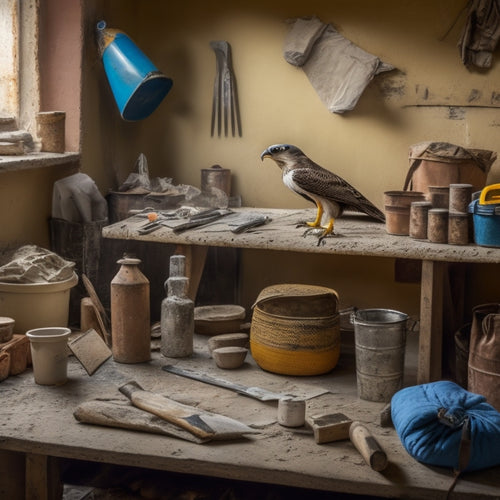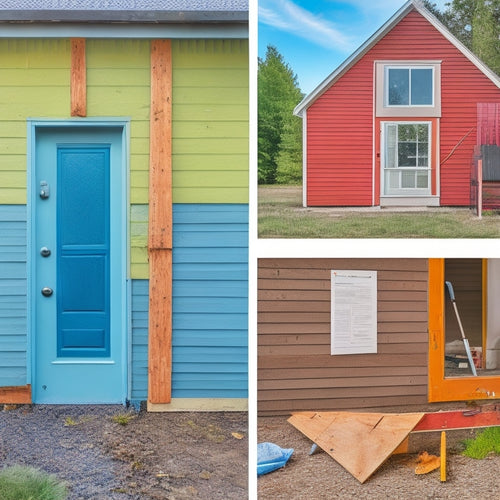
3 Best Grinding Tools for Home Renovation Projects
Share
When tackling home renovation projects involving concrete work, you need a reliable grinding tool to guarantee efficiency and quality. For large areas, consider a walk-behind grinder with a diamond blade for effective grinding and polishing. For smaller areas, a handheld grinder with variable speed control and dust extraction system is ideal. Additionally, an angle grinder with an aluminum oxide wheel is suitable for metalwork. By choosing the right grinder, you'll complete tasks efficiently and safely. Now, discover how to prioritize essential features like power, speed, and ergonomic design to take your project to the next level.
Key Takeaways
• Choose the right grinder type (angle, die, or belt) and wheel material (diamond or aluminum oxide) for your specific project needs.
• Consider a walk-behind grinder for large areas and a handheld grinder for smaller areas, corners, and edges.
• Prioritize safety by wearing protective gear, ensuring proper ventilation, and using dust extraction systems.
• Look for essential features like variable speed controls, overload protection, and ergonomic design for efficient and safe grinding.
• Select a grinder with sufficient power and speed to complete tasks efficiently and effectively.
Choosing the Right Grinder
When selecting a grinder for your home renovation project, consider the type of material you'll be working with, as this will determine the appropriate grinder speed and wheel type to choose.
For instance, if you're working with concrete, you'll need a grinder with a high torque and a diamond wheel. On the other hand, if you're working with metal, a grinder with a lower torque and an aluminum oxide wheel will suffice.
There are several grinder types to choose from, including angle grinders, die grinders, and belt grinders. Each type has its own unique features and applications, so it's crucial to choose the right one for your project.
Additionally, don't forget to prioritize safety tips when working with grinders. Always wear protective gear, such as gloves and safety glasses, and make certain proper ventilation to avoid inhaling dust and debris.
Keep your work area clean and clear of obstacles to avoid accidents. By choosing the right grinder and following these safety tips, you'll be able to complete your home renovation project efficiently and safely.
Top Concrete Grinding Options
Your concrete grinding tasks require a grinder that can effectively remove old coatings, smooth out rough surfaces, and prepare the floor for new finishes. For concrete grinding, you'll need a powerful tool that can handle the tough task.
One top option is a walk-behind grinder, which is ideal for large areas and provides excellent surface preparation. These grinders are equipped with diamond blades that effectively grind and polish concrete, leaving a smooth finish.
Another option is a handheld grinder, perfect for smaller areas, corners, and edges. These compact tools are lightweight and easy to maneuver, making them ideal for tight spaces. They're also great for removing old coatings and preparing surfaces for new finishes.
When it comes to concrete grinding, surface preparation is vital. You need a grinder that can effectively remove old coatings, dirt, and debris to guarantee a strong bond between the old and new surfaces.
Essential Features to Consider
As you select a grinding tool for your concrete grinding tasks, you must prioritize essential features that guarantee efficient and effective performance. With so many grinder types available, it's vital to focus on the features that matter most.
First and foremost, consider the power and speed of the grinder. A more powerful motor will enable you to complete tasks quickly and efficiently. Additionally, look for grinders with variable speed controls to give you more flexibility and precision.
When it comes to safety features, don't compromise. Here are a few key features to look for:
-
Dust extraction systems to minimize airborne particles
-
Overload protection to prevent motor burnout
-
Ergonomic design for reduced fatigue and improved handling
Frequently Asked Questions
Can I Use a Grinder for Tasks Other Than Grinding Concrete?
You can leverage a grinder's versatility for alternative applications beyond concrete grinding, such as cutting metal pipes, sharpening tools, or removing rust and paint, making it a valuable addition to your toolkit.
How Often Should I Replace My Grinder's Abrasive Wheels?
You're wondering how often to swap out those abrasive wheels, aren't you? Well, it depends on the signs: decreased grinder performance, excessive vibration, or worn-out wheels. Typically, they last 6-12 months, but inspect them every 3-4 months to guarantee peak grinder performance.
Are Grinder Safety Glasses Sufficient for Eye Protection?
When grinding, you should know that grinder safety glasses alone might not meet safety eyewear standards; you're better off wearing goggles or face shields that provide more extensive grinder eye protection.
Can I Grind Concrete in a Small, Enclosed Space Safely?
"When you're tackling tight spaces, take caution: carefully calculate ventilation requirements and implement dust control measures to minimize exposure, ensuring a safer concrete grinding experience in those small, enclosed areas you're working in."
Are There Any Specific Storage Requirements for Grinders?
When storing your grinder, you'll want to guarantee proper maintenance by keeping it dry, clean, and away from sparks or flames. Invest in storage solutions like protective cases or bags to prevent damage and extend its lifespan.
Conclusion
With the right grinder in hand, your home renovation project will be a breeze - a million times easier, in fact!
You'll be able to tackle even the toughest tasks with ease, from smoothing out rough concrete to removing old tile adhesive.
By considering the essential features and choosing from our top concrete grinding options, you'll be well on your way to achieving professional-looking results without breaking a sweat.
Related Posts
-

Top Tools for DIY Home Renovation Plastering Success
To achieve DIY home renovation plastering success, you'll need a range of essential tools. Start with hand tools like...
-

Trowel Tool Cost for DIY Home Renovation Projects
When it comes to your DIY home renovation project, you'll need to budget for a variety of trowel tools, including stu...
-

Why Exterior Wall Renovation Requires a Plan
You're about to commence a complex and potentially costly project when you decide to renovate your exterior walls, an...


